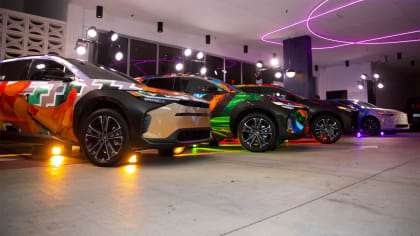GOING ELECTRIC
A new LEAF on life
This article is from our archives and has not been updated and integrated with our "new" site yet... Even so, it's still awesome - so keep reading!
Published on Mon, Aug 26, 2013
By: The LACar Editorial Staff

By Benno Wang
In 1964, when I was an engineering student in California, an older classmate built an all electric truck. We were all impressed, rode it around the campus, and were surprised that it actually worked. One thing I can never forget is that the truck bed was filled with rows and rows of lead acid batteries and tangled with large cables—not a pretty sight. At that time, I learned that the future of the electric car is in the hands of better batteries. After 50 years of waiting, lithium-ion batteries are here, and the time is ripe for mass-produced electric cars.
Fast forward to today: After days of study and comparison, the two finalists in my search for an electric car are the Nissan LEAF (Leading, Environmentally friendly, Affordable, Family car) and the Chevy Volt. The Leaf is more efficient than the Chevy Volt, but the Volt has a much better driving range due to its back-up internal combustion engine. However, buying a Volt is like buying an electric car plus a large gas-fired generator. And you have to carry this generator around town whether you use it or not. That simply didn’t make sense to me. On the other hand, Nissan LEAF is 100 percent electric—and because it is pure electric, it has fewer parts than the Volt. In theory, then, it should have fewer things that could go wrong, and therefore require less maintenance. In short, the LEAF is a much simpler car.

We live on the Big Island of Hawaii. My neighbor Gail bought a Nissan LEAF about two and a half years ago. I asked her about the reliability of her Nissan LEAF. She said, "I have driven the Nissan LEAF more than two years now. The only thing that I have changed is a pair of windshield wipers." That did it. I decided that it was time to buy a Nissan LEAF.
Much to my surprise, there was no auto dealer on the Big Island who sold the Nissan LEAF. The closest place to buy a Nissan LEAF was on the island of Maui. I figured that if the car was so reliable and trustworthy, what do you need a nearby dealer for? I studied the LEAF 's user manual and found that the car does not need much maintenance. The services are all basic ones, such as tire rotation, checking the brake fluid level, changing the AC filter, and changing the windshield wipers. That is about it. I contacted Jim Falks Motors in Maui. They said that they had sold over 60 Nissan LEAFs to the Big Island. All 60 plus of us are trusting that the Nissan LEAF will not fail and therefore not need service.
When the LEAF arrived at the Hilo shipping dock, we had a hard time trying to start the car. After ten minutes of struggling, we realized that the car had already started. It was just so quiet that we simply did not know it was already running.

It took four months of waiting to receive our new 2013 Nissan LEAF. During this waiting time, I installed 34 solar panels on my roof. I also installed my own 240V charging station purchased from Amazon.com. We drove the LEAF into our garage and plugged it in. It worked instantly. Within a couple of hours, it was fully charged. Four months have passed, and we have no electric bill and no gas bill. How nice!
The characteristics of the LEAF are well known. Popular Mechanics said it well: "A pure EV with space for five, a moderate price and enough range for most tasks—plus an operating cost that's irresistibly low." Quiet and smooth acceleration. Very responsive. I have heard that New York City started a pilot program of Nissan LEAF taxi cabs. It makes sense.
In Hawaii, we are blessed with good weather all year round. We really don't need the air conditioner or heater. But we set the AC to 65 degrees—that’s a luxury. Fortunately, there is not a significant reduction in mileage. And speaking of luxuries, the Bose sound system in the 2013 model is a big plus.
The most exciting surprise is the range of the car. The EPA rated range is 76 miles, but we are continuously getting around 105 miles. Maybe it’s because we have no freeway. The maximum driving speed anywhere on the island is 55 miles per hour. I learned that a few unhappy LEAF customers are in Arizona. Could it be that the very hot and dry climate are bad for Nissan LEAF batteries? Hilo is a small 40,000-person town. We have never driven the car on the last 20 miles of reserve. I am happy that this car is ideal with our environment. Everything works better in paradise.

The 2013 Nissan LEAF is rated by the EPA at 129 (city)/102 (highway) miles per gallon equivalent (115 MPGe combined). In Hawaii, the electricity rate is 43 cents per kWh, so the actual MPG is really only about 39 MPG. Therefore, it is not truly all that economical to own an electric car in Hawaii due to the high price of electricity. However, if you produce your own power at 10 cents per kWh, then the LEAF can be rated at 156 MPG, which is exactly what I did.
In my opinion, the right unit to express an electric car's efficiency should be miles per kilowatt hour (kWh). According to the EPA, the 2013 Nissan LEAF is rated at 29 kWh per 100 miles, or about 3.4 miles per kWh. The 2013 Chevy Volt is rated at 2.9 miles per kWh, and the most efficient version of the 2013 Tesla Model S is rated at 2.9 miles per kWh.
I am a bit concerned about the battery capacity loss problem. The warranty is that the car will still have 76 percent of the battery's capacity after five years or 60,000 miles of usage. My neighbor has logged 30,000 miles so far, but she has not noticed any capacity loss. Only time can tell. That's why I leased the car. The battery industry has been making steady progress in recent years. Two years from now, they may have better batteries available. Then, I may buy a new Nissan LEAF to keep.
The main driver of the LEAF is my granddaughter, Margot who uses it to drive to college every day. When she has no class, my spouse and I will fight over who gets to drive it. We have two other gas engine cars, a Honda CRV and a Toyota Tundra truck. In the past four months, each car visited the gas station only twice (we drive them only when the LEAF was not available). We have driven the Leaf 4,842 miles thus far. No problems, no complaints, and no regrets. Most of all, I am happy to be contributing to a sustainable future.

School will be starting. Margot went to get a parking permit, but the university told her that for electrical vehicles, parking is free. She also found a new charge station in the campus (and the charging is also free). Life is good in a LEAF.
SIDEBAR COMMENT
If you have the good fortune of a lifestyle that can accommodate the range of an electric car, you’ll be hard pressed to find a better buy than the Nissan LEAF. For 2013, Nissan dropped the price of a LEAF by $6,400, from $35,200 to $28,800, thanks in part to a new base model, the S. Factor in the Federal tax credit, that brings the net price down to $21,300. For Californians, there’s a $2,500 cash rebate, yielding an astonishing net price of $18,800—and that’s not even counting additional dealer discounts that might be available through the Automobile Club of Southern California (AAA).
Also new for 2013 is a new 6.6-kW onboard charger in the premium models that cuts charging times in half. Following the lead of some popular hybrid models, Nissan also included a "B" driving mode in the LEAF that acts like a low gear for deceleration, but which also increases regenerative braking. Last, but not least, the LEAF is now assembled in the USA, as are the batteries and electric motors that go into it. – Roy Nakano
Editor’s Note: A former Silicon Valley high technology industry engineer, Benno Wang retired, bought a one-acre piece of land near Hilo, Hawaii, built his house from the ground up, designed a self sustaining water reclamation system, and installed 34 solar panels. He's now on a NEM (National Electricity Market) style arrangement where any excess electricity he produces from the solar panels goes back to the electric company to power other parts of the city. If he needs the power, the electric company will provide it. So far, however, his solar panels have been consistently producing more than he needs.
For more information about Nissan products, go to www.nissanmotors.com

SPECIFICATIONS
Name of vehicle:
2013 Nissan LEAF
Price:
$28,800 (base model)
$18,800 (base model net after Federal tax credit and California cash rebate)
EPA estimates
Fuel economy: 129 city/102 highway/115 combined MPGe
29 kilowatt hours per 100 miles (3.4 miles per kWh)
Range: 76 miles
Engine type:
electric
Transmission:
1-speed direct drive
Drive configuration:
Front-wheel drive
Suspension
Front: Independent MacPherson struts with stabilizer bar
Rear: Torsion beam with stabilizer bar
Dimensions
Overall length: 175 inches
Overall width: 69.7 inches
Overall height: 61 inches
Curb weight (lbs.): 3,291 pounds





